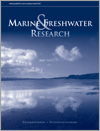Marine and Freshwater Research
Volume 74
Number 11 2023
Native fish populations in Australia’s Murray–Darling Basin have experienced severe declines since European settlement. We quantified trends in populations of six large-bodied fish species in New South Wales from 1994 to 2022. Results showed strong inter-annual variation in relative abundance, biomass and population structure for all species, with little evidence of continued decline of native species since the 1990s.
Plastic pollution is a growing problem, with microplastics commonly found in marine ecosystems. We investigated plastic presence in water, sediment and marine biota in South Australia, to see if biomagnification was occurring. We found plastic in 35% of water, 45% of sediment and 39% of biota species. No biomagnification was identified, although similarities in microplastics across biota suggest trophic transfer.
We investigated the seasonal fertility of the kelp Ecklonia radiata and the links between fertility and environmental conditions. We found that kelps growing in warm water had low but year-round fertility that increased in response to episodic swell and rainfall events. This differed from kelps growing in cooler waters, which have defined fertile seasons related to water temperature. This means that patterns in the fertility of kelps vary among populations that are exposed to different environmental conditions.
The Ramsar Convention on Wetlands is a critical tool in global efforts to conserve wetlands and their myriad values. In this paper, we pilot the Rapid Ramsar Management Effectiveness Evaluation Tool in the Caroni Swamp Ramsar Site in Trinidad. We found serious gaps in capacity and institutional context that undermine implementation of the Ramsar Convention in the twin island nation.
Otolith nitrogen isotope ratios represent the nitrogen source of fish because the isotope ratios are consistent between diet and otolith. Carbon isotope ratio is significantly higher in otolith organic matter than that in diet. The isotope ratios of otolith organic matter are useful for studying feeding ecology of fishes, especially when metabolic tissues or diet are not available.
We have assessed possible spatial stock structure of a catfish (Rita rita) in the Ganges Basin. Multiple approaches, namely, truss morphometry, otolith chemistry and otolith shape, were used to suggest spatial structuring. Each of the methods delineated the fish groups from different sampling locations as separate stocks.
Field surveys found that the selective feeding of crown-of-thorns starfish on coral reefs of the South China Sea differed from that in other coral reef regions worldwide. The dominant genera, Montipora and Pocillopora, have differing damages because of the selective feeding, leading to an altered coral community that is likely to be vulnerable to ocean warming. This case study suggests that crown-of-thorns starfish not only directly consume coral individuals but also may indirectly affect the vulnerability of the coral community to climate warming.
The article includes results of two species of sea turtle hatchlings’ seaward orientation accuracy. Understanding the orientation performance of hatchlings by species is important in assessing the need for and effects of nesting beach management practices, such as sand nourishment. Our study assessed the effects of dune proximity on hatchling orientation in two species of sea turtle. In past, no study has compared orientation among species in one site.
 , H. T. Schilling
, H. T. Schilling  , D. M. Gilligan, M. Asmus, C. A. Boys
, D. M. Gilligan, M. Asmus, C. A. Boys  , G. L. Butler, L. M. Cameron, D. Hohnberg, L. E. Michie, N. G. Miles, T. S. Rayner, W. A. Robinson, M. L. Rourke, J. R. Stocks
, G. L. Butler, L. M. Cameron, D. Hohnberg, L. E. Michie, N. G. Miles, T. S. Rayner, W. A. Robinson, M. L. Rourke, J. R. Stocks  , J. D. Thiem
, J. D. Thiem  , A. Townsend, D. E. van der Meulen
, A. Townsend, D. E. van der Meulen  , I. Wooden and K. J. M. Cheshire
, I. Wooden and K. J. M. Cheshire 




